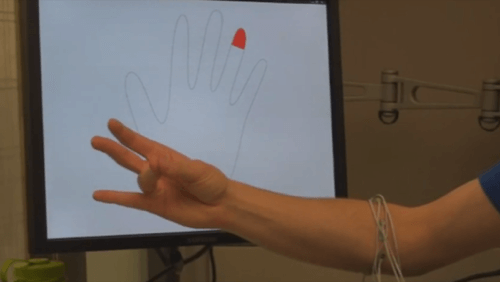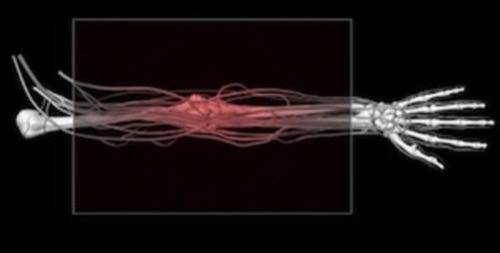
In the future, Microsoft apparently believes, people may simply twitch their fingers or arms to control a computer, game console or mobile device.
Microsoft applied for a patent on electromyography (EMG) controlled computing on Thursday, suggesting that a future smart wristwatch or armband might simply detect a user’s muscle movements and interpret them as gestures or commands. The “Wearable Electromyography-Based Controller” could also use a network of small sensors attached to the body, all communicating wirelessly with a central hub.
Patents can typically take years to approve, and Microsoft’s approach doesn’t mean that the PC of tomorrow will replace a mouse or keyboard with a network of sensors stuck to the bottom via adhesive tape. Microsoft also showed off a prototype of an EMG controller in 2010, and has filed complementary EMG controller patents as well as a patent covering the gestures used to control them.

Biometric Control
Researchers have long looked for alternative methods of controlling devices biometrically, with varying degrees of success. Microsoft first treated the human body as just another input device when it launched the Kinect sensor, which tracks a user’s face and body via an onboard camera. Computing via brainwaves has also been proposed as an alternative method of input. Finally, EMG-controlled devices, such as prosthetics, have been talked about for some time. Still, all three methods have their challenges.
But EMG-based computing does imply several interesting possibilities: the ability to type without a keyboard; wiggling a finger, rather than an arm, to provide fine-grained Kinect controls; or new ways to control “waldos” and other robotic appendages. Microsoft even suggests that a glove-based version of the EMG controller might be used to automatically translate American Sign Language into written or spoken English or other languages. That’s pretty cool.
Microsoft’s patent application claims that an EMG sensor is a “universal” method of controlling any computing device, such as a television or light sensor. That may be true, although something like voice commands could also control just about anything. However, it does offer some sneaky, secret-agent possibilities:
“Further, it should also be appreciated that the control and interface capabilities provided by the Wearable Electromyography-Based Controller are potentially invisible in the sense that a user wearing one or more such controllers can remotely interact with various devices without anyone else being able to see or hear any overt actions by the user to indicate that the user is interacting with such devices,” the patent application says.
How Does It Work?
The human skeleton is connected via tendons. When the brain tells a tendon to contract, motor neurons fire, transmitting tiny electrical signals down to the muscle fiber. An EMG sensor can read the electrical impulses these so-called “motor units” produce. What Microsoft’s patent proposes to do is to interpret these electrical signals without the need for a physical interface.
These sensors could be built into any number of devices or articles of clothing: watches or armbands, anklets, potentially even a Spandex undergarment.
The problem, and one Microsoft’s application goes into great lengths to compensate for, is calibration. Fat, skin and other muscles interfere with the minute electrical signals the sensors need to detect, so one of two things must occur: either a single sensor must be well placed, or a network of sensors needs to interact with each other to interpret the signals. The most likely possibility is that the sensor would need to provide some sort of feedback: either a tone to indicate that the sensor is properly aligned, a voice signal (“Keep turning! Keep turning! Got it!”) or some other way of notifying the user. Microsoft also suggests a variety of other methods, including using RF signals to position the sensors or even applying minute electrical shocks so that the sensors can calibrate themselves.

The EMG sensors would, most likely, connect wirelessly to a central hub or controller, which would serve as the central point for communicating with external devices. Microsoft suggests that this hub could be something like a smartphone, or an integrated device like a wristwatch, with the “watch” portion serving as the hub, and sensors built into the band itself – a truly “smart watch.”
Twitch gestures
You don’t always think about this when using a keyboard or mouse, but a physical device provides either haptic, tactile or visual feedback. Twitching a muscle to surreptitiously control an electronic device may or may not be properly recognized, or the user may simply not know if the command was accepted.
Microsoft’s armband – the preferred EMG controller, based on the number of times this example is used – would include a ring of vibrating elements around the edge of each armband, which would buzz the user when a command was accepted. The system could be programmed for any number of muscle movements or twitch gestures, defined as “a finger movement of any type,” Microsoft says. “A gesture may also be for a specific type of movement, for example, lift, press, bend, etc.”
And yes, Microsoft even suggests that the system be turned off and on through a standardized movement, such as squeezing both hands simultaneously. And that’s good news, or else “talking with your hands” might take on a whole new meaning.
Images courtesy of Shutterstock.










